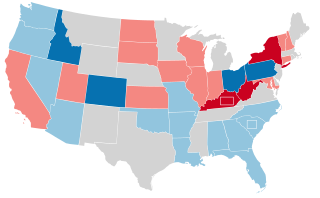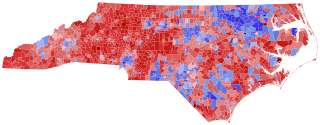| |||||||||||||||||
| |||||||||||||||||
| |||||||||||||||||
| Elections in North Carolina |
|---|
 |
The 1880 North Carolina gubernatorial election was held on November 2, 1880. Incumbent Democrat Thomas Jordan Jarvis defeated Republican nominee Ralph P. Buxton with 51.32% of the vote.
| |||||||||||||||||
| |||||||||||||||||
| |||||||||||||||||
| Elections in North Carolina |
|---|
 |
The 1880 North Carolina gubernatorial election was held on November 2, 1880. Incumbent Democrat Thomas Jordan Jarvis defeated Republican nominee Ralph P. Buxton with 51.32% of the vote.
The Democratic convention was held on June 17, 1880. [1]
| Party | Candidate | Votes | % | |
|---|---|---|---|---|
| Democratic | Thomas Jordan Jarvis | 680 | 54.93 | |
| Democratic | Daniel Gould Fowle | 449 | 36.27 | |
| Democratic | Alfred Moore Scales | 108 | 8.72 | |
| Total votes | 1,238 | 100.00 | ||
The Republican convention was held on July 7, 1880. [1]
| Party | Candidate | Votes | % | |
|---|---|---|---|---|
| Republican | Ralph P. Buxton | 215 | 92.67 | |
| Republican | Oliver H. Dockery | 17 | 7.33 | |
| Total votes | 232 | 100.00 | ||
| Party | Candidate | Votes | % | ±% | |
|---|---|---|---|---|---|
| Democratic | Thomas Jordan Jarvis (incumbent) | 121,837 | 51.32% | ||
| Republican | Ralph P. Buxton | 115,559 | 48.68% | ||
| Majority | 6,278 | ||||
| Turnout | |||||
| Democratic hold | Swing | ||||

Elections to choose members of the North Carolina Council of State were held on Tuesday, November 2, 2004.

Thomas Jordan Jarvis was the 44th governor of the U.S. state of North Carolina from 1879 to 1885. Jarvis later served as a U.S. Senator from 1894 to 1895, and helped establish East Carolina Teachers Training School, now known as East Carolina University, in 1907.

The 1970 United States Senate elections was an election for the United States Senate. It took place on November 3, with the 33 seats of Class 1 contested in regular elections. Special elections were also held to fill vacancies. These races occurred in the middle of Richard Nixon's first term as president. The Democrats lost a net of three seats, while the Republicans and the Conservative Party of New York picked up one net seat each, and former Democrat Harry F. Byrd Jr. was re-elected as an independent.

The 1958 United States Senate elections were elections for the United States Senate which occurred in the middle of President Dwight D. Eisenhower's second term. Thirty-two seats of Class 1 were contested in regular elections, the new state of Alaska held its first Senate elections for its Class 2 and 3 seats, and two special elections were held to fill vacancies.

The 1956 United States Senate elections were elections for the United States Senate that coincided with the re-election of President Dwight D. Eisenhower. The 32 seats of Class 3 were contested in regular elections, and three special elections were held to fill vacancies. Although Democrats gained two seats in regular elections, the Republicans gained two seats in special elections, leaving the party balance of the chamber unchanged.

The 1946 United States Senate elections were held November 5, 1946, in the middle of Democratic President Harry S. Truman's first term after Roosevelt's passing. The 32 seats of Class 1 were contested in regular elections, and four special elections were held to fill vacancies. The Republicans took control of the Senate by picking up twelve seats, mostly from the Democrats. This was the first time since 1932 that the Republicans had held the Senate, recovering from a low of 16 seats following the 1936 Senate elections.

The 1938 United States House of Representatives elections in South Carolina were held on November 8, 1938, to select six Representatives for two-year terms from the state of South Carolina. The primary elections were held on August 30 and the runoff elections were held two weeks later on September 13. Three incumbents were re-elected, but two incumbents were defeated in the Democratic primary. The three open seats were retained by the Democrats and the composition of the state delegation thus remained solely Democratic.

The North Carolina United States Senate election of 1972 was held on 7 November 1972 as part of the nationwide elections to the Senate, and coinciding with the 1972 presidential election. The general election was fought between the Republican nominee Jesse Helms and the Democratic nominee Rep. Nick Galifianakis. Helms won the election, becoming the first Republican to win a Senate seat in North Carolina since 1903, and the first to hold this seat since 1871.

The 2016 North Carolina lieutenant gubernatorial election took place on November 8, 2016, to elect the Lieutenant Governor of North Carolina, concurrently with the 2016 U.S. presidential election, as well as elections to the United States Senate and elections to the United States House of Representatives and various state and local elections. Primary elections were held March 15.

The 2016 United States House of Representatives elections in North Carolina were held on November 8, 2016, to elect the 13 U.S. representatives from the state of North Carolina, one from each of the state's 13 congressional districts. The elections coincided with the 2016 U.S. presidential election, as well as other elections to the House of Representatives, elections to the United States Senate and various state and local elections.

The 2020 United States House of Representatives elections in North Carolina were held on November 3, 2020, to elect the 13 U.S. representatives from the state of North Carolina, one from each of the state's 13 congressional districts. The elections coincided with the 2020 U.S. presidential election, as well as other elections to the House of Representatives, elections to the United States Senate and various state and local elections.

The 1940 North Carolina gubernatorial election was held on November 5, 1940. Democratic nominee J. Melville Broughton defeated Republican nominee Robert H. McNeill with 75.70% of the vote.

The 1936 North Carolina gubernatorial election was held on November 3, 1936. Democratic nominee Clyde R. Hoey defeated Republican nominee Gilliam Grissom with 66.69% of the vote.

The 1892 North Carolina gubernatorial election was held on November 8, 1892. Democratic nominee Elias Carr defeated Republican nominee David M. Furches with 48.3% of the vote. Harry Skinner unsuccessfully ran for the Populist nomination.

The 1888 North Carolina gubernatorial election was held on November 6, 1888. Democratic nominee Daniel Gould Fowle defeated Republican nominee Oliver H. Dockery with 51.97% of the vote.

The 1884 North Carolina gubernatorial election was held on November 4, 1884. Democratic nominee Alfred Moore Scales defeated Republican nominee Tyre York with 53.80% of the vote.

The 1876 North Carolina gubernatorial election was held on November 7, 1876. Democratic nominee Zebulon Baird Vance defeated Republican nominee Thomas Settle with 52.83% of the vote.

An election was held on November 3, 2020 to elect all 50 members to North Carolina's Senate. The election coincided with the elections for other offices, including the Presidency, U.S Senate, Governor, U.S. House of Representatives, and state house. The primary election was held on March 3, 2020 with a run-off on June 23, 2020.

The 2020 United States attorney general elections were held on November 3, 2020, in 10 states. The previous attorney general elections for this group of states took place in 2016, except in Vermont where attorneys general only serve two-year terms and elected their current attorney general in 2018. Nine state attorneys general ran for reelection and eight won, while Republican Tim Fox of Montana could not run again due to term limits and Republican Curtis Hill of Indiana was eliminated in the Republican convention.

An election was held on November 8, 2022, to elect all 50 members to North Carolina's Senate. The election coincided with the elections for other offices, including the U.S Senate, U.S. House of Representatives, and state house. The filing period lasted from February 24, 2022, to March 4, 2022, with the primary election being held on May 17, 2022. The elections were originally to be held under new districts passed by the General Assembly in Senate Bill 739 to account for population changes following the 2020 census, however, following a ruling by the North Carolina Supreme Court, the General Assembly redrew the maps to comply with the court's ruling.